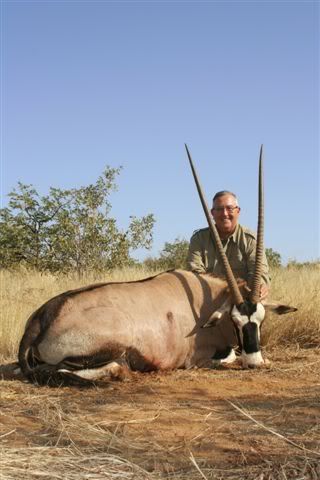| mikeh416Rigby |
| (.450 member) |
| 20/09/08 02:54 PM |

|
|
|
Quote:
An excellent safari.
Mike, what is the Caprivi Strip terrain generally like? Is it mostly open country like where you took the buffalo or more scrub and forest? A mixture of both? Is most hunting done on the plains? Thanks.
The terrain in this area of the Caprivi is mostly open flood plain. A month before my hunt, this area was totally inaccessable by vehicles. Boats and mokoros are the only way to get around then. Vaughan has a couple of boats available, including a customized pontoon boat with two tents on the roof. He also does a fair amount of fly camping if the herds are too far from main camp. There are some low, gentle hills, which are of course islands in the wet season. According to Vaughan, in most years, the biggest bulls come over from Botswana in late September, into October. There are also a lot of elephant in this area. The day after I shot my Buffalo, a hunter from California shot a 60# = - Bull. This was his 2nd hunting day. A friend of mine went along on this trip, having booked a 16 day Elephant and Cape Buffalo Hunt. On the next to last day he killed a 60 plus pound Bull. He told me that he also wounded, and lost a Buff after it crossed the Chobe into Botswana. He also took a nice Blue Wildebeest, and his son shot a nice Impala Ram. Of course, there are lots, and lots of Zebra, it's just a matter of picking out the pattern on the hide that strikes your fancy. Interestingly enough, a lot of the Zebra in this area have no shadow stripes.
Now, just for clarification, I took my bull on the Kasika Conservancy, which is about as far east as you can be in the Caprivi. Our camp was on the Salambala Conservancy which adjoins it. The Salambala is a much larger conservancy, and actually straddles both sides of the road from Katima Mulolo, to the Botswana Border. The Salambala also has a large flood plain, but has a lot of sand forest that borders the Chobe. This area is also mostly flat. Vaughan does a lot of his Elephant hunting here. This is where the California hunter in camp took his bull, and so did my friend.
THE FOLLOWING IS FROM VAUGHAN'S WEBSITE:
The Salambala Communal Conservancy area borders on the Zambezi in the north and runs right down to the Chobe in the south, offering elephant hunting and buffalo hunting. In 2005, the average on elephant was 51 lbs. The 200 000 acre Salambala Conservancy was the first conservancy to be registered in Namibia. It is roughly 40 km east of Katima Mulilo.
The Kasika Communal Conservancy is in the Zambezi Flood Basin in the far east of the Caprivi strip. The terrain in these areas is very flat, with huge grass flood plains and some forest and scrub areas.
The Caprivi Strip of Namibia feels very different than our hunting areas in the North West of Namibia. This is the Africa of one's imagination with Buffalo, Hippo, Elephant, Lion, Jackal, Impala, and Kudu being just a few of the species found here.
www.fultonclassicsafaris.com